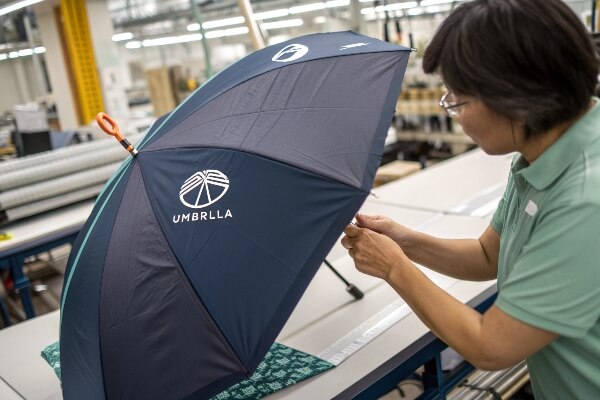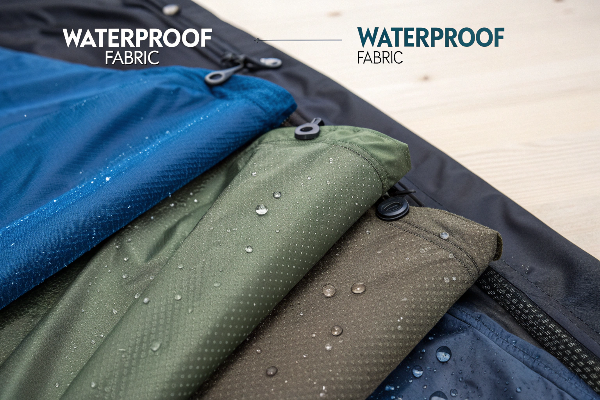How are umbrellas manufactured?

I used to think umbrellas were simple, but the process is more complex than most imagine. Because of that, I want to show you the details.
Umbrellas are manufactured through a step-by-step process that combines material selection, canopy printing, careful assembly, and strict quality testing. In addition, manufacturers add custom design options to meet customer needs.
The story of umbrellas is not only about keeping dry. Instead, it is about the blend of science, craft, and design. So, stay with me as I guide you through every step.
What raw materials are used in umbrellas?
I often hear people ask what umbrellas are made of, and many are surprised by the answer.
Umbrellas use fabrics like nylon, polyester, pongee, and vinyl for canopies. In addition, they use metals or fiberglass for frames, while wood or plastic is chosen for handles. As a result, each part has a clear purpose.

When we think about umbrella materials, it is best to break them into three main parts: canopy, frame, and handle.
Canopy Fabrics
The canopy is the most visible part. For example:
- Nylon dries fast and resists water.
- Polyester is strong and common in fashion umbrellas.
- Pongee has a tight weave and smooth texture, good for prints.
- Satin is glossy and stylish, but less common.
- Vinyl gives us clear umbrellas.
Here is a quick comparison for clarity:
| Fabric | Key Feature | Common Use |
|---|---|---|
| Nylon | Quick-drying | Folding umbrellas |
| Polyester | Durable | Fashion umbrellas |
| Pongee | Smooth finish | Printed designs |
| Satin | Glossy | Fashion umbrellas |
| Vinyl | Transparent | Clear umbrellas |
Frame Materials
Frames are like the skeleton. Steel and aluminum are often used because they are strong. Fiberglass bends without breaking; therefore, it is perfect for golf umbrellas. Wood adds a touch of style, and as a result, it is common in patio and luxury umbrellas.
Handles
Handles come in plastic, wood, or metal. For example, teak and bamboo are popular in premium designs.
When you hold an umbrella, you are holding a mix of advanced materials. Each choice is made because of strength, style, and comfort.
How is the umbrella canopy printed?
When I design custom umbrellas, printing is always a big decision.
Umbrella canopies are printed using digital printing, dye sublimation, UV printing, or screen printing. Each method suits different fabrics and design needs. In fact, the printing step often defines how the umbrella will look and perform.

Printing turns an umbrella into a statement piece. For example, a golf umbrella may carry a brand logo, while a fashion umbrella may show bold artwork.
Printing Methods
| Printing Type | Strengths | Best Use |
|---|---|---|
| Digital Printing | High detail, full color | Photo designs |
| Dye Sublimation | Vivid, permanent | Polyester canopies |
| UV Printing | Scratch-resistant | Outdoor umbrellas |
| Screen Printing | Classic logos | Simple branding |
How It Works
- Digital Inkjet places images directly on fabric. As a result, details stay sharp.
- Dye Sublimation infuses color deep into polyester, so prints last.
- UV Printing uses special ink hardened by light; therefore, the finish is durable.
- Screen Printing works with stencils, so it is ideal for bold, simple logos.
This step is where umbrellas stop being just tools. Instead, they become part of someone’s brand or style.
What steps are in umbrella assembly?
I once visited a factory floor, and watching the assembly line was eye-opening.
Umbrella assembly involves preparing the base, securing the pole, attaching the canopy, adding features, and making final adjustments. Each step matters because stability and function depend on it.
Let’s break it down into simple steps.
Assembly Stages
- Base Setup – Flat surface, stable support.
- Install Pole – Insert and tighten with screws.
- Fill Base – Sand or water adds weight; therefore, it stays firm.
- Attach Canopy – Secure the ribs and fabric.
- Add Features – Crank handle, tilt, or solar panel.
- Final Check – Open, close, and test stability.
Here is a summary table to compare:
| Step | Purpose |
|---|---|
| Prepare base | Stability |
| Install pole | Structure |
| Fill base | Weight |
| Attach canopy | Function |
| Add features | Usability |
| Final check | Quality |
Each umbrella, whether for rain or patio, goes through a similar routine. However, small details like the tension of the ribs or the smoothness of the crank handle make a huge difference.
How is umbrella quality tested?
I always tell buyers that a good umbrella is not proven by design alone, but by how it performs in real life.
Umbrella quality is tested through rain resistance, wind resistance, durability checks, ease of use, and portability. In addition, patio umbrellas face extra weather and rust tests.
Testing Methods
- Rainproofness – Simulated rain ensures no leaks. As a result, the user stays dry.
- Wind Resistance – Strong fans test if ribs can flip back; however, they must not snap.
- Durability – Open and close cycles measure wear. In addition, material strength is checked.
- Ease of Use – Smooth mechanics are essential because customers expect comfort.
- Portability – Folding umbrellas are tested for weight and storage.
For patio umbrellas:
- Rust resistance and UV exposure tests are added.
- Mechanisms like tilt and swivel are tested many times.
| Test | Focus | What Success Looks Like |
|---|---|---|
| Rainproofness | Coverage | No leaks |
| Wind resistance | Stability | Flips back |
| Durability | Lifespan | No cracks |
| Ease of use | Comfort | Smooth action |
| Portability | Travel use | Light, compact |
These tests make sure the umbrella you buy will not fail at the worst moment. Instead, it will work when the rain or wind surprises you.
Why do manufacturers offer custom designs?
When I speak with clients, custom design is often the deal-maker.
Manufacturers offer custom designs to meet unique client needs, build brand recognition, and create stronger customer relationships. In addition, customization improves efficiency and reduces waste.
Why Customization Matters
- Brand Identity – Logos and colors make umbrellas brand tools.
- Customer Loyalty – A personal product feels special; therefore, customers return.
- Flexibility – Small batches meet diverse demands.
- Efficiency – Custom orders cut waste and improve margins.
Here is a quick breakdown to compare benefits:
| Benefit | Why It Helps |
|---|---|
| Brand Identity | Makes businesses stand out |
| Customer Loyalty | Stronger connections |
| Flexibility | Fits specific needs |
| Efficiency | Reduces waste |
The Bigger Picture
Customization is not just a sales gimmick. Instead, it allows direct collaboration with clients. From drawings to delivery, the process ensures umbrellas fit exact requirements. As a result, this builds trust, and trust builds repeat business. In addition, it allows manufacturers to charge higher prices for unique designs, while offering customers something mass production never could: identity.
Conclusion
Umbrellas are not simple tools. In summary, they result from smart materials, skilled printing, precise assembly, strict testing, and custom creativity.


